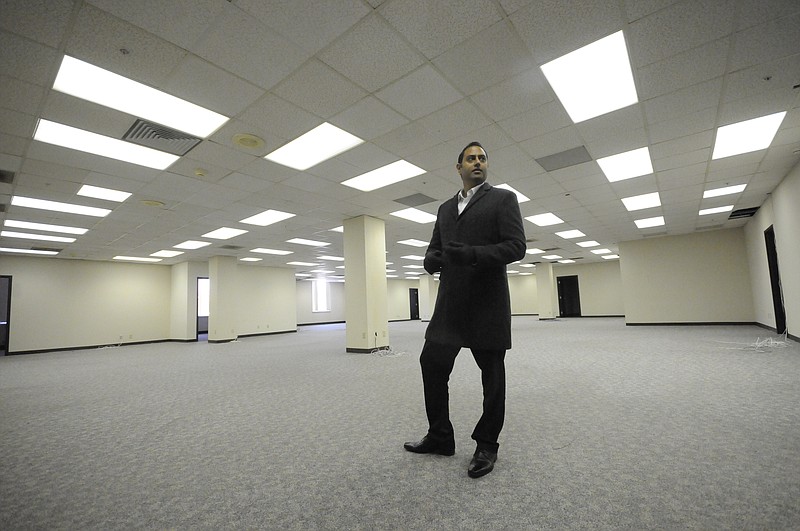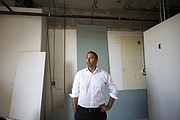New downtown apartments built or currently in the works
› Douglas Heights, 691 beds› UTC dorm, 600 beds› Cameron Harbor, 220 units› 1400 Chestnut St., 220 units› Vine Street, 200 units tentatively planned› 700 block of Market Street, 125 units› 110 Tremont St., 53 units› Chattanooga Choo Choo, 97 units› Maclellan Building, 90 units› North Shore apartments, 84 units› Vine and Houston, 68 units› Market and Main, 63 units› Clemon Bros. Building, 54 units› Tomorrow Building, 49 units› Walk2Campus apartments, 34 units› Vine and Lindsay, 31 beds
On a rainy spring morning, Vic Desai, a principal at Chattanooga-based ViaNova Development, officially opened his company's new, 54-unit apartment building in downtown Chattanooga. Built in the 100-year-old Clemons Bros. Building at the corner of Eighth and Chestnut Streets, the apartments boasts high ceilings, 18-inch plank floors and a sturdy, concrete construction not often found in newer buildings.
The Clemons building was originally constructed for the manufacturing and sale of furniture. It was later converted into BueCross BlueShield office space, complete with sheet rock walls, carpets and suspended ceilings. When Desai and Company bought the old building, it had been sitting empty for years, and the floors remained largely as BlueCross BlueShield had left them when the insurance giant relocated to Cameron Hill.
In late 2014, ViaNova went to work retrofitting the six-story building for hip, urban loft-style downtown apartments on a $7.5 million budget. The ground floor is reserved for retail space.
"When you make this kind of investment, there's a multiplier effect for our city," Mayor Andy Berke says.
The downtown development promoter River City Co. estimated two years ago that Chattanooga faced a shortage of at least 3,500 student units and 2,300 conventional apartment units.
The new downtown housing won't just vacuum up suburban renters. In fact, Chattanooga's traditional apartment markets are seemingly as strong as ever. In April, Collegedale resident and builder Bobby Adamson announced plans to continue building out his 300-unit Summit Pointe complex. Belle Investment Group, of Knoxville, recently wrapped up work on a 312-unit apartment in Ooltewah called The Legends at White Oak. Off Little Debbie Parkway in Collegedale, Integra Hills is expanding with plans to grow to more than 500 units. In Hixson, the Hillocks Farm mixed-use development on north Highway 153 is at last moving toward adding a 280-unit apartment complex. Nearby, ASA Engineering is developing plans for a 308-unit complex on Highway 153 near Target. And in Cleveland, Tennessee, work is underway on the third and final phase of the 400-unit Brookes Edge apartment complex.
Building activity has been just as strong downtown. Witness the crane off E. 10th Street at the site of rising 600-bed complex Douglas Heights, and in the mainstay traffic barrels at the intersection of Main and Market Streets, as Mission at Main, and its 63 residential units, comes online this year. Last year, Choo Choo Partners opened Passenger Flats, a collection of almost 100 small-footprint units retrofitted into what were formerly Chattanooga Choo Choo hotel rooms. In November, Knoxville-based Belle Development Group also received approval for construction of a contentious seven-story apartment building in the 1200 block of Cowart Street to introduce 140 more units. And earlier this year, Belle Development announced plans for another downtown project to construct mixed-use space and 220 residential units near Erlanger Hospital.
This year alone, private builders and developers are set to invest about $524 million in downtown housing, adding 1,888 new rental apartment units and 1,400 student beds.
Amy Donahue, marketing and communications manager at River City Co., says the city is on the right track.
"Even with the current development that's in the pipeline, that doesn't meet pent-up demand," she says. "I don't think that saturation is, in any way, an issue."
Consider these numbers, Donahue says: The mark of a healthy city with a lively night and weekend scene, is when roughly 10 percent of downtown employees also live downtown. She points to Chattanooga's often-mentioned counterpart, Asheville, N.C., as a good example. In Asheville, roughly 8.1 percent of downtown workers live downtown. In Charleston, S.C., meanwhile, roughly 10 percent of downtown workers also live downtown.
In Chattanooga right now, only about 3 percent of downtown workers live downtown, and it's in part because for years there has been nowhere downtown to live. The annual apartment market by the commercial real estate firm Rock Apartment Advisers indicates downtown Chattanooga currently has an average rental unit occupancy rate of 98 percent.
Another study conducted by Noell Consulting Group for River City Co., estimates the downtown housing market will continue to grow by 150 units each year.
Donahue believes the city currently faces a "Field of Dreams" moment: If developers build it, renters will come.
But what happens when a host of new units comes online this year, and more continue to come up downtown?
"I really think that the occupancy level would stay that high (at 98 percent), because the number of available apartment units downtown is so low," Donahue says.

